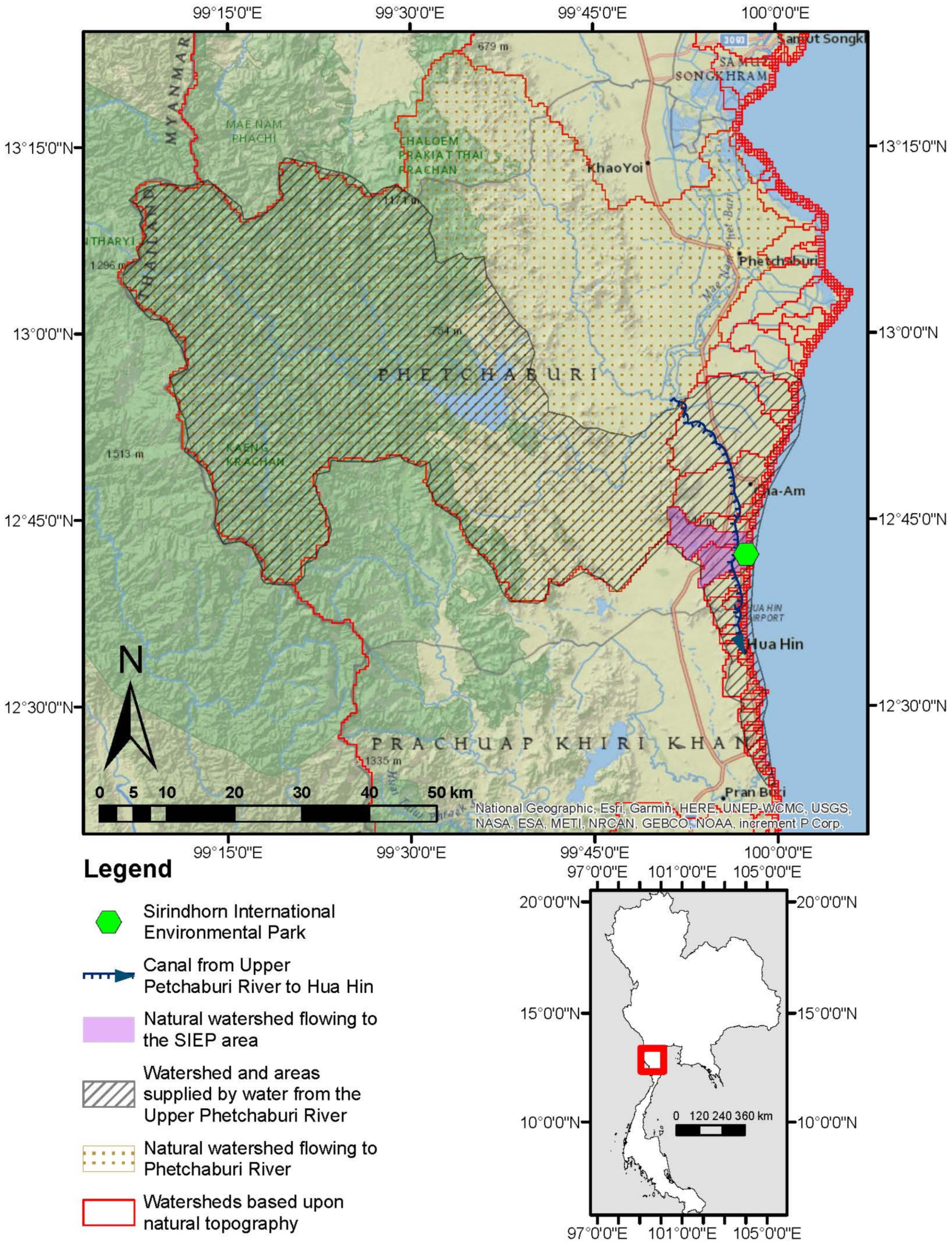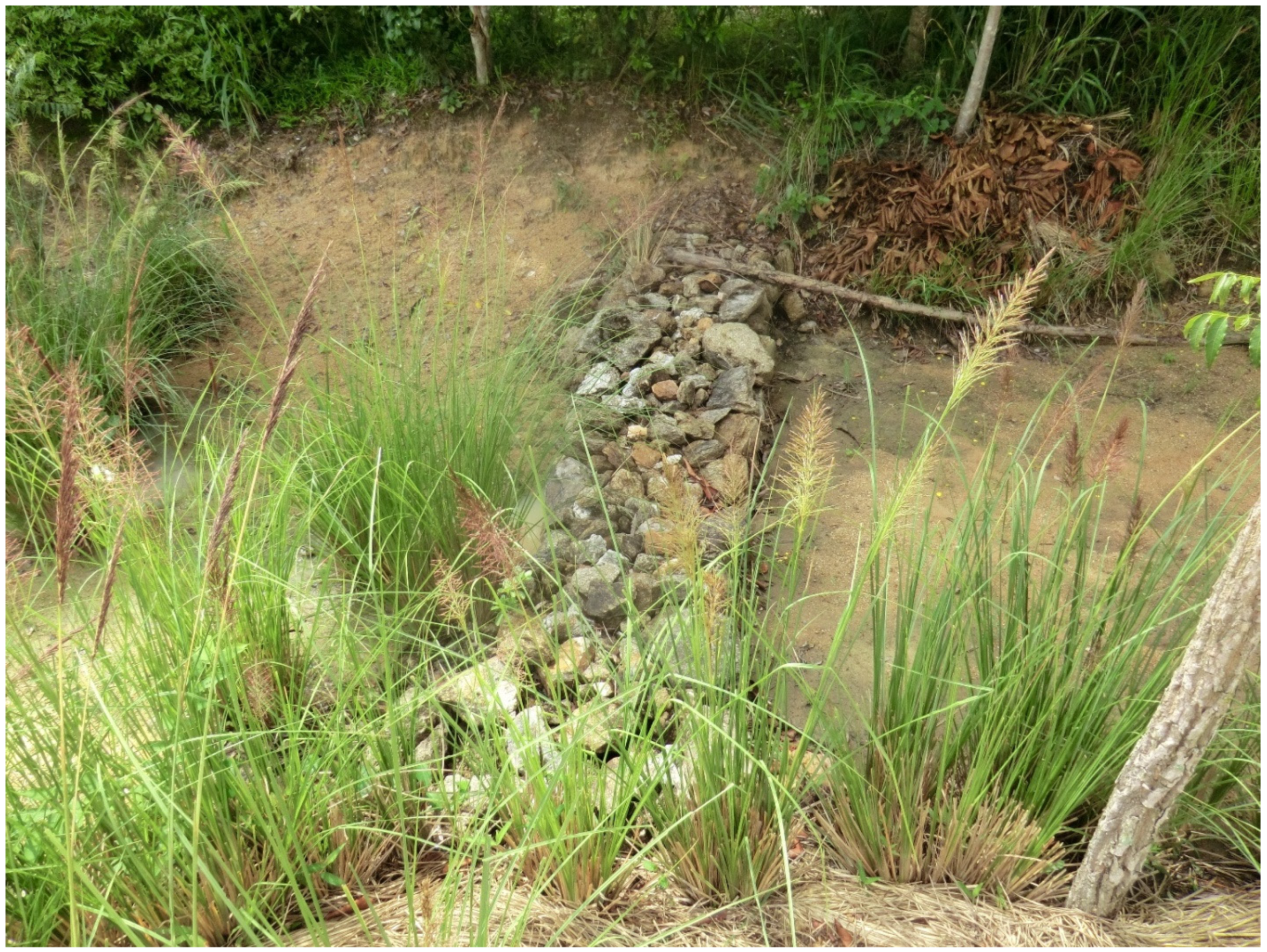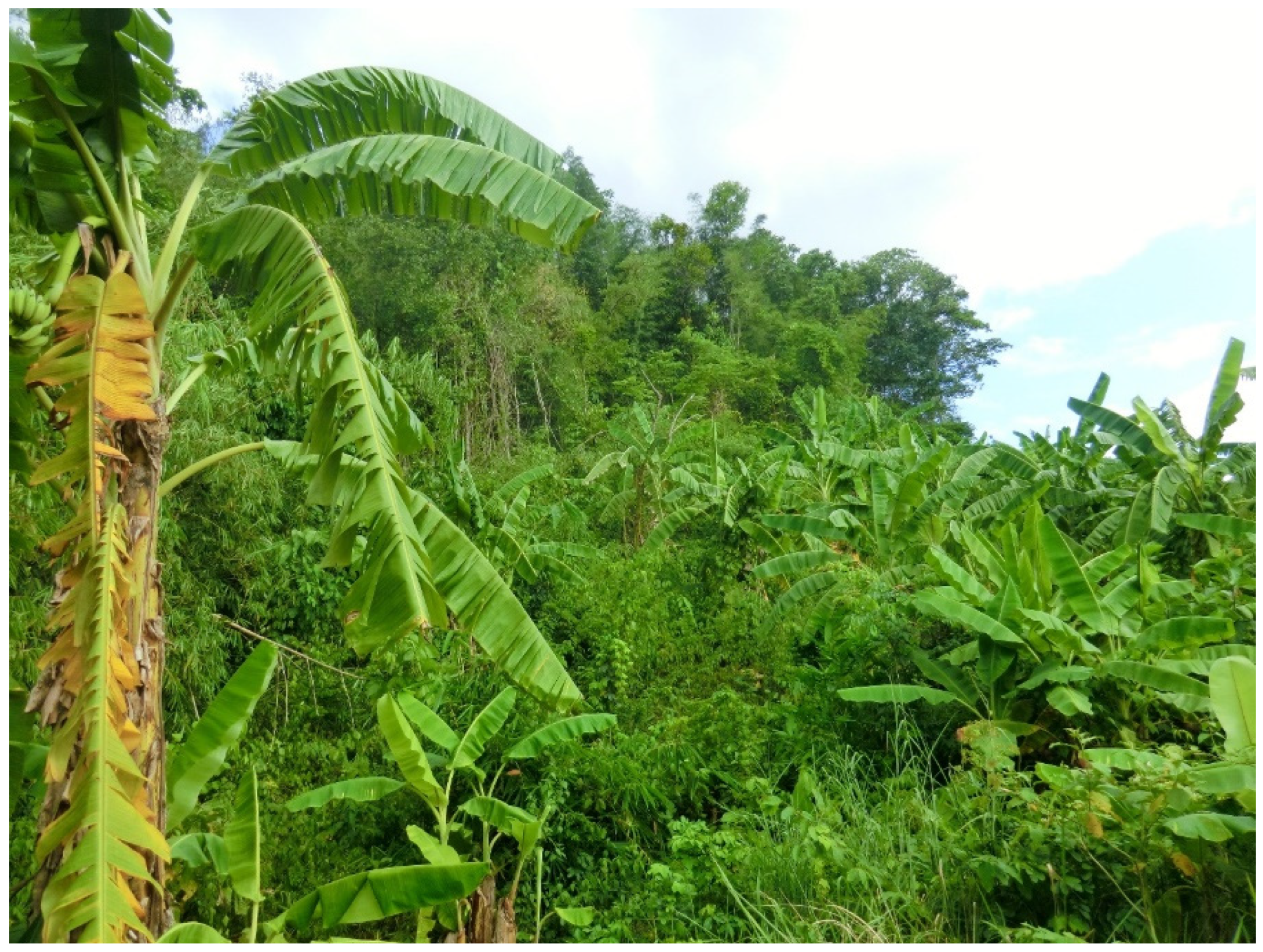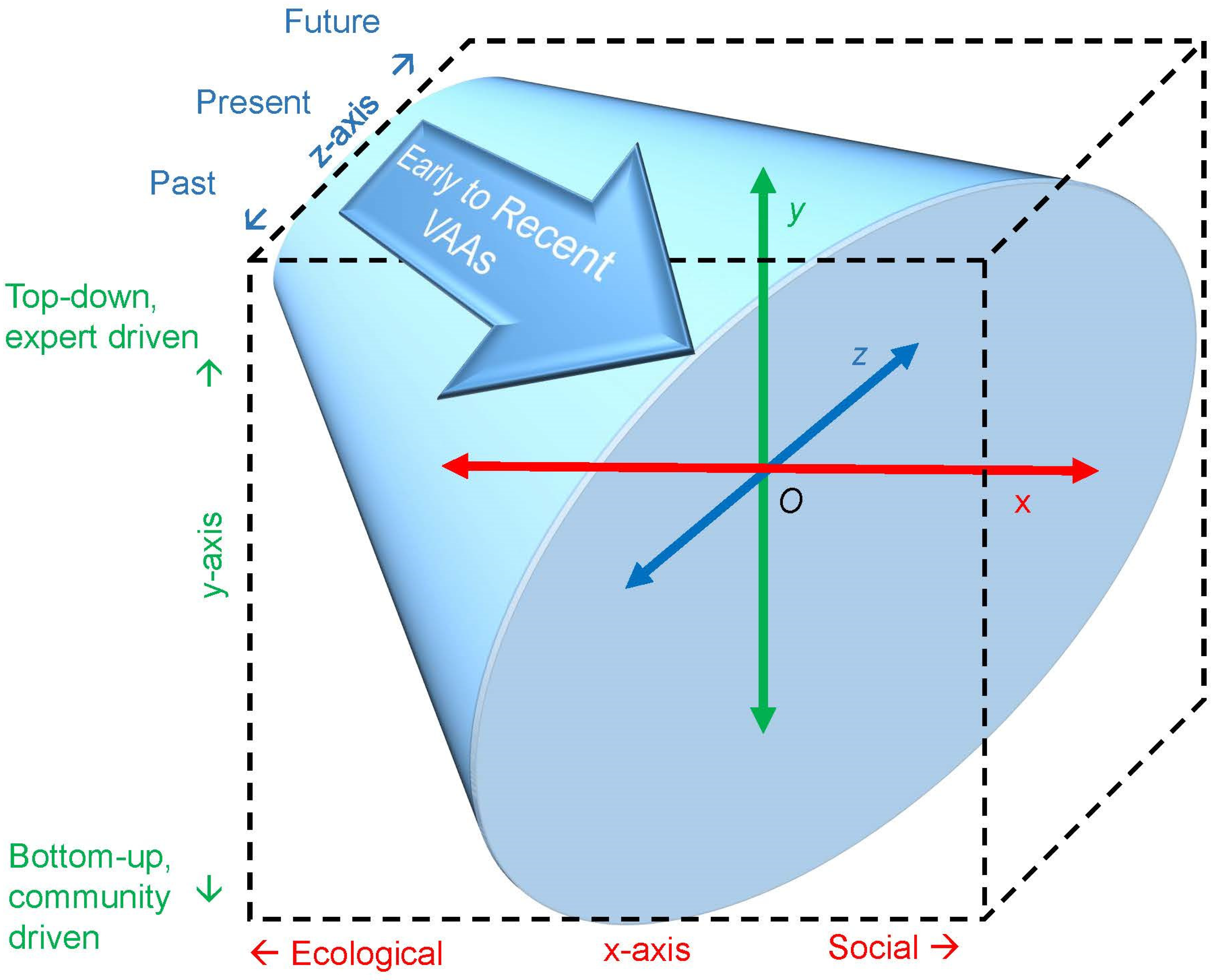Shifting Perspectives in Assessing Socio-Environmental Vulnerability
Abstract
:1. Introduction
1.1. Background
1.2. SIEP Project Case Study: Watershed-Scale Climate Vulnerability Assessment and Adaptation Planning in Thailand
2. Review of Vulnerability Literature
2.1. Guidance for VAAs in the US
2.2. An Evolving Foundational Concept: Ecological Restoration
3. Findings from the Review and Case Study
3.1. Important Framing Questions Considered in the SIEP Project
3.1.1. What Is the Appropriate Management Unit?
3.1.2. Is Downscaled Climate Data Necessary?
3.1.3. Is Ecological Restoration or Socio-Economic Development the Priority?
3.1.4. Are Roads an Ecological Liability or a Resource for Reducing Social Vulnerability?
3.1.5. What Are the Costs and Benefits of Dams and Diversions?
3.1.6. Is the Focus on Sustaining Forests or Sustaining Forest-Dependent People?
3.1.7. Is Fire to Be Restored or Excluded?
3.2. General Themes in VAAs Represented by Three Axes
3.2.1. Social-Ecological Considerations
3.2.2. Information Sources and Process
3.2.3. Temporal References
3.3. Lessons Learned for Achieving Better Integrated VAAs
3.3.1. Humans are Part of Most Natural Systems
3.3.2. The Ecological Restoration Framework Can Be Broadened to Include Social Considerations
3.3.3. Consideration of Social Adaptive Capacity, Including Governance Institutions, May Increase the Relevance of VAAs
3.3.4. Community Engagement in the Development of Indicators May Increase Their Effectiveness
3.3.5. Integrated Science and Monitoring Contribute to Effective Management in the Long Term
3.3.6. Integration of Top-Down and Bottom-Up Approaches Is Necessary to Solve Complex Problems
4. Conclusions
Author Contributions
Funding
Acknowledgments
Conflicts of Interest
References
- United Nations Framework Convention on Climate Change. Adoption of the Paris Agreement FCCC/CP/2015/L.9/Rev.1; United Nations Framework Convention on Climate Change: Paris, France, 2015. [Google Scholar]
- Smajgl, A.; Salamanca, A.; Steel, A.; Blate, G.; Long, J.; Hartman, P.; Manuamom, O.; Sawhney, P.; Friend, R.; Gustafson, S.; et al. Watershed Vulnerability and Adaptation Assessments in the Greater Mekong Subregion: Guidelines for Climate Change Practitioners; Greater Mekong Subregion (GMS) Roundtable for Climate Adaptation: Bangkok, Thailand, 2018. [Google Scholar]
- Peterson, D.L.; Millar, C.I.; Joyce, L.A.; Furniss, M.; Halofsky, J.E.; Neilson, R.; Morelli, T.L. Responding to Climate Change in National Forests: A Guidebook for Developing Adaptation Options; USDA Forest Service, Pacific Northwest Research Station: Portland, OR, USA, 2011.
- Füssel, H.-M.; Klein, R.J. Climate change vulnerability assessments: An evolution of conceptual thinking. Clim. Chang. 2006, 75, 301–329. [Google Scholar] [CrossRef]
- David-Chavez, D.M.; Gavin, M.C. A global assessment of Indigenous community engagement in climate research. Environ. Res. Lett. 2018, 13, 123005. [Google Scholar] [CrossRef]
- Amiott, J. Investigating the Convention on Biological Diversity’s protections for traditional knowledge. Mo. Environ. Law Policy Rev. 2003, 11, 3–37. [Google Scholar]
- Connelly, A.; Carter, J.; Handley, J.F.; Hincks, S. Enhancing the practical utility of risk assessments in climate change adaptation. Sustainability 2018, 10, 1399. [Google Scholar] [CrossRef] [Green Version]
- Hares, M. Forest conflict in Thailand: Northern minorities in focus. Environ. Manag. 2008, 43, 381–395. [Google Scholar] [CrossRef] [PubMed]
- Shott, J. Vulnerability and Capacity Assessment (VCA): An Integrated Approach for Local Stakeholders. Powerpoint; Asia Pacific Adaption Network. Available online: http://www.asiapacificadapt.net/adaptationforum2012/sites/default/files/SDF%20VCA%20Synthensized%20Ver06%20Adapt%20Forum.pdf (accessed on 3 February 2020).
- Dillard, D.; Rose, C.; Conard, S.; MacCleery, D.; Ford, L.; Conant, K.; Cundiff, A.; Trapani, J. Forest Service Strategic Framework for Responding to Climate Change; USDA Forest Service: Washington, DC, USA, 2008.
- Tkacz, B.; Brown, H.; Daniels, A.; Acheson, A.; Cleland, D.; Fay, F.; Johnson, R.; Kujawa, G.; Roper, B.; Stritch, L. National Roadmap for Responding to Climate Change; USDA Forest Service: Washington, DC, USA, 2010.
- Joyce, L.A.; Blate, G.M.; McNulty, S.G.; Millar, C.I.; Moser, S.; Neilson, R.P.; Peterson, D.L. Managing for multiple resources under climate change: National forests. Environ. Manag. 2009, 44, 1022–1032. [Google Scholar] [CrossRef] [Green Version]
- Swanston, C.; Maria, E.J. Forest Adaptation Resources: Climate Change Tools and Approaches for Land Managers; Gen. Tech. Rep. NRS-GTR-87; USDA Forest Service, Northern Research Station: Newtown Square, PA, USA, 2012.
- Furniss, M.; Roby, K.B.; Cenderelli, D.; Chatel, J.; Clifton, C.F.; Clingenpeel, A.; Hays, P.E.; Higgins, D.; Hodges, K.; Howe, C.; et al. Assessing the Vulnerability of Watersheds to Climate Change: Results of National forest Watershed Vulnerability Pilot Assessments; Gen. Tech. Rep. PNW-GTR-884; USDA Forest Service, Pacific Northwest Research Station: Portland, OR, USA, 2013.
- Spies, T.A.; Giesen, T.W.; Swanson, F.J.; Franklin, J.F.; Lach, D.; Johnson, K.N. Climate change adaptation strategies for federal forests of the Pacific Northwest, USA: Ecological, policy, and socio-economic perspectives. Landsc. Ecol. 2010, 25, 1185–1199. [Google Scholar] [CrossRef]
- MacClune, K.; Opitz-Stapleton, S. Building Urban Resilience to Climate Change; ISET-International: Boulder, CO, USA, 2012. [Google Scholar]
- Fischer, A.P.; Paveglio, T.; Brenkert-Smith, H.; Carroll, M.; Murphy, D. Assessing social vulnerability to climate change in human communities near public forests and grasslands: A framework for resource managers and planners. J. For. 2013, 111, 357–365. [Google Scholar] [CrossRef] [Green Version]
- Swanston, C.W.; Janowiak, M.K.; Brandt, L.A.; Butler, P.R.; Handler, S.D.; Shannon, P.D.; Lewis, A.D.; Hall, K.R.; Fahey, R.T.; Scott, L.; et al. Forest Adaptation Resources: Climate Change Tools and Approaches for Land Managers; Gen. Tech. Rep. NRS-GTR-87–2; USDA Forest Service, Northern Research Station: Newtown Square, PA, USA, 2016.
- Hand, M.S.; Eichman, H.; Triepke, F.J.; Jaworski, D. Socioeconomic Vulnerability to Ecological Changes to National Forests and Grasslands in the Southwest; Gen. Tech. Rep. RMRS-GTR-383; USDA Forest Service, Rocky Mountain Research Station: Fort Collins, CO, USA, 2018.
- Armatas, C.A.; Borrie, W.T.; Watson, A.E. Protocol for Social Vulnerability Assessment to Support National Forest Planning and Management: A Technical Manual for Engaging the Public to Understand Ecosystem Service Tradeoffs and Drivers of Change; Gen. Tech. Rep. RMRS-GTR-396; USDA Forest Service, Rocky Mountain Research Station: Fort Collins, CO, USA, 2019.
- Norton-Smith, K.; Lynn, K.; Chief, K.; Cozzetto, K.; Donatuto, J.; Redsteer, M.H.; Kruger, L.E.; Maldonado, J.; Viles, C.; Whyte, K.P. Climate Change and Indigenous Peoples: A Synthesis of Current Impacts and Experiences; Gen. Tech. Rep. PNW-GTR-944; USDA Forest Service, Pacific Northwest Research Station: Portland, OR, USA, 2016.
- Norgaard, K.M. Salmon & Acorns Feed Our People: Colonialism, Nature, & Social Action; Rutgers University Press: New Brunswick, NJ, USA, 2019. [Google Scholar]
- Tribal Adaptation Menu Team. Dibaginjigaadeg Anishinaabe Ezhitwaad: A Tribal Climate Adaptation Menu; Great Lakes Indian Fish and Wildlife Commission: Odanah, WI, USA, 2019. [Google Scholar]
- Case-Scott, H.; Lynn, K. Review of tribal climate change plans. In Understanding Effects of Climate Change on Forest Resources for Tribal Communities in the Pacific Northwest and Northern California; Lake, F.K., Long, J.W., Norgaard, K.M., Lynn, K., Case-Scott, H., Eds.; (unpublished, manuscript in preparation).
- Reinecke, S.; Blum, M. Discourses across scales on forest landscape restoration. Sustainability 2018, 10, 613. [Google Scholar] [CrossRef] [Green Version]
- Biswas, S.; Mallik, A.U.; Choudhury, J.K.; Nishat, A. A unified framework for the restoration of Southeast Asian mangroves—Bridging ecology, society and economics. Wetl. Ecol. Manag. 2008, 17, 365–383. [Google Scholar] [CrossRef]
- Keane, R.; Hessburg, P.F.; Landres, P.B.; Swanson, F.J. The use of historical range and variability (HRV) in landscape management. For. Ecol. Manag. 2009, 258, 1025–1037. [Google Scholar] [CrossRef]
- Timberlake, T.J. Climate Change Adaptation on Public Lands: Policy, Vulnerability Assessments, and Resilience in the US Forest Service. Ph.D. Thesis, Colorado State University, Fort Collins, CO, USA, 2019. [Google Scholar]
- MacQuarrie, P.R. Resilience of Large River Basins: Applying Social-Ecological Systems Theory, Conflict Management, and Collaboration on the Mekong and Columbia Basins. Ph.D. Thesis, Oregon State University, Corvallis, OR, USA, 2012. [Google Scholar]
- Smith, T. Climate Vulnerability in Asia’s High Mountains; Technical Report to USAID; World Wildlife Fund: Washington, DC, USA, 2014. [Google Scholar]
- Foti, R.; Ramirez, J.A.; Brown, T.C. Vulnerability of US Water Supply to Shortage: A Technical Document Supporting the Forest Service 2010 RPA Assessment; USDA Forest Service, Rocky Mountain Research Station: Fort Collins, CO, USA, 2012.
- Boonyawat, S.; Kheereemangkla, Y.; Puk-ngam, S.; Thueksathit, S.; Tongdeenok, T.; Kaewjampa, N.; Havanond, S.; Sittiyanpaiboon, A. Integrated Watershed Ecosystem Management: A Case of Forest and Water Resources in Bangtranoi and Huaisai Watershed, Cha-am District, Phetchaburi Province; International Conference on Climate Change: Phetchaburi Province, Thailand, 2016. [Google Scholar]
- Campbell, J.D.; Taylor, M.A.; Stephenson, T.S.; Watson, R.A.; Whyte, F.S. Future climate of the Caribbean from a regional climate model. Int. J. Clim. 2010, 31, 1866–1878. [Google Scholar] [CrossRef]
- Cayan, D.R.; Maurer, E.; Dettinger, M.D.; Tyree, M.; Hayhoe, K. Climate change scenarios for the California region. Clim. Chang. 2008, 87, 21–42. [Google Scholar] [CrossRef]
- Opitz-Stapleton, S.; MacClune, K. Chapter 11 Scientific and social uncertainties in climate change: The Hindu Kush-Himalaya in regional perspective. In Climate Change Modeling for Local Adaptation in the Hindu Kush-Himalayan Region; Lamadrid, A., Kelman, I., Eds.; Emerald Group Publishing Limited: Bingley, UK, 2012. [Google Scholar]
- Shrestha, S. Assessment of water availability under climate change scenarios in Thailand. In Climate Change Impacts and Adaptation in Water Resources and Water Use Sectors; Shrestha, S., Ed.; Springer International Publishing: New York, NY, USA, 2014. [Google Scholar]
- Steel, E.A.; Marsha, A.; Fullerton, A.H.; Olden, J.D.; Larkin, N.K.; Lee, S.-Y.; Ferguson, A. Thermal landscapes in a changing climate: Biological implications of water temperature patterns in an extreme year. Can. J. Fish. Aquat. Sci. 2019, 76, 1740–1756. [Google Scholar] [CrossRef]
- Hall, M. Earth Repair: A Transatlantic History of Environmental Restoration; University of Virginia Press: Charlottesville, VA, USA, 2005. [Google Scholar]
- Lasco, R.D.; Cruz, R.; Pulhin, J.; Pulhin, F. Assessing Climate Change Impacts, Vulnerability and Adaptation: The Case of Pantabangan-Carranglan Watershed; World Agroforestry Centre-Philippines: Laguna, Philippines, 2010. [Google Scholar]
- Halofsky, J.E.; Peterson, D.L.; O’Halloran, K.A.; Hoffman, C.H. Adapting to Climate Change at Olympic National Forest and Olympic National Park; Gen. Tech. Rep. PNW-GTR-844; USDA Forest Service, Pacific Northwest Research Station: Portland, OR, USA, 2011.
- Long, J.W.; Lake, F.K. Escaping social-ecological traps through tribal stewardship on national forest lands in the Pacific Northwest, United States of America. Ecol. Soc. 2018, 23, 1–14. [Google Scholar] [CrossRef]
- Yusuf, A.A.; Francisco, H. Climate change vulnerability mapping for Southeast Asia. In Economy and Environment Program for Southeast; Economy and Environment Program for Southeast Asia (EEPSEA): Singapore, 2009. [Google Scholar]
- Kondolf, G.M. The Espace de Liberté and restoration of fluvial process: When can the river restore itself and when must we intervene. In River Conservation and Management; John Wiley & Sons, Ltd.: Chichester, UK, 2012; pp. 223–241. [Google Scholar]
- Chornesky, E.A.; Ackerly, D.D.; Beier, P.; Davis, F.W.; Flint, L.E.; Lawler, J.J.; Moyle, P.B.; Moritz, M.A.; Scoonover, M.; Byrd, K. Adapting California’s ecosystems to a changing climate. Bioscience 2015, 65, 247–262. [Google Scholar] [CrossRef] [Green Version]
- Hogan, Z.; Na-Nakorn, U.; Kong, H. Threatened fishes of the world: Pangasius sanitwongsei Smith 1931 (Siluriformes: Pangasiidae). Environ. Biol. Fishes 2008, 84, 305–306. [Google Scholar] [CrossRef]
- Kittikhoun, A.; Staubli, D.M. Water diplomacy and conflict management in the Mekong: From rivalries to cooperation. J. Hydrol. 2018, 567, 654–667. [Google Scholar] [CrossRef]
- Flood, J.P.; McAvoy, L.H. Use of national forests by Salish? Kootenai tribal members: Traditional recreation and a legacy of cultural values. Leisure/Loisir 2007, 31, 191–216. [Google Scholar] [CrossRef]
- Keller, R.H.; Turek, M.F. American Indians and National Parks; University of Arizona Press: Tucson, AZ, USA, 1999. [Google Scholar]
- Catton, T. American Indians and National Forests; University of Arizona Press: Tucson, AZ, USA, 2016. [Google Scholar]
- McElwee, P.D. Displacement and relocation redux: Stories from Southeast Asia. Conserv. Soc. 2006, 4, 396–403. [Google Scholar]
- Jennings, L.N.; Douglas, J.; Treasure, E.; González, G. Climate Change Effects in El Yunque National Forest, Puerto Rico, and the Caribbean Region; Gen. Tech. Rep. SRS-GTR-193; USDA Forest Service, Southern Research Station: Asheville, NC, USA, 2014.
- Stott, P.A.; Goldammer, J.G.; Werner, W.L. The role of fire in the tropical lowland deciduous forests of Asia. In Ecological Studies; Springer Science and Business Media LLC: Berlin/Heidelberg, Germany, 1990; Volume 84, pp. 32–44. [Google Scholar]
- Lake, F.K.; Long, J.W. Fire and Tribal Cultural Resources; Gen. Tech. Rep. PSW-GTR-247; USDA Forest Service, Pacific Southwest Research Station: Albany, CA, USA, 2014.
- Lynn, K.; Daigle, J.; Hoffman, J.; Lake, F.; Michelle, N.; Ranco, D.; Viles, C.; Voggesser, G.; Williams, P. The impacts of climate change on tribal traditional foods. Clim. Chang. 2013, 120, 545–556. [Google Scholar] [CrossRef]
- Kershner, J.; Samhouri, J.F.; James, C.A.; Levin, P.S. Selecting indicator portfolios for marine species and food webs: A Puget Sound case study. PLoS ONE 2011, 6, e25248. [Google Scholar] [CrossRef] [PubMed] [Green Version]
- Spies, T.A.; White, E.M.; Kline, J.D.; Fischer, A.P.; Ager, A.A.; Bailey, J.D.; Bolte, J.; Koch, J.; Platt, E.; Olsen, C.S.; et al. Examining fire-prone forest landscapes as coupled human and natural systems. Ecol. Soc. 2014, 19, 9. [Google Scholar] [CrossRef] [Green Version]
- Timberlake, T.J.; Schultz, C.A. Policy, practice, and partnerships for climate change adaptation on US national forests. Clim. Chang. 2017, 144, 257–269. [Google Scholar] [CrossRef]
- Timberlake, T.J.; Schultz, C.A. Climate change vulnerability assessment for forest management: The case of the U.S. forest service. Forests 2019, 10, 1030. [Google Scholar] [CrossRef] [Green Version]
- James, C.A.; Kershner, J.; Samhouri, J.; O’Neill, S.; Levin, P.S.; Kershner, J. A methodology for evaluating and ranking water quantity indicators in support of ecosystem-based management. Environ. Manag. 2012, 49, 703–719. [Google Scholar] [CrossRef]
- Green, D.; Niall, S.; Morrison, J. Bridging the gap between theory and practice in climate change vulnerability assessments for remote Indigenous communities in northern Australia. Local Environ. 2012, 17, 295–315. [Google Scholar] [CrossRef]
- Eriksen, S.E.H.; Aldunce, P.; Bahinipati, C.S.; Martins, R.; Molefe, J.I.; Nhemachena, C.; O’Brien, K.; Olorunfemi, F.; Park, J.; Sygna, L.; et al. When not every response to climate change is a good one: Identifying principles for sustainable adaptation. Clim. Dev. 2011, 3, 7–20. [Google Scholar] [CrossRef]
- Gustafson, S.; Cadena, A.J.; Ngo, C.C.; Kawash, A.; Saenghkaew, I.; Hartman, P. Merging science into community adaptation planning processes: A cross-site comparison of four distinct areas of the Lower Mekong Basin. Clim. Chang. 2017, 149, 91–106. [Google Scholar] [CrossRef]
- Smajgl, A.; Ward, J. Evaluating participatory research: Framework, methods and implementation results. J. Environ. Manag. 2015, 157, 311–319. [Google Scholar] [CrossRef]
- Whyte, K. Indigenous climate change studies: Indigenizing futures, decolonizing the anthropocene. Engl. Lang. Notes 2017, 55, 153–162. [Google Scholar] [CrossRef]
- Fillmore, H.M. TahoeLand Live! National Public Radio TahoeLand Podcast. Romero, E.D., Ed.; Available online: http://www.capradio.org/news/tahoeland/2019/10/10/tahoeland-live/ (accessed on 18 October 2019).
- Berry, P.; Enright, P.M.; Shumake-Guillemot, J.; Prats, E.V.; Campbell-Lendrum, D. Assessing health vulnerabilities and adaptation to climate change: A review of international progress. Int. J. Environ. Res. Public Health 2018, 15, 2626. [Google Scholar] [CrossRef] [PubMed] [Green Version]
- Avelino, J.E.; Crichton, R.; Valenzuela, V.P.B.; Odara, M.G.N.; Padilla, M.A.T.; Kiet, N.; Danh, T.N.; Van, P.C.; Bao, H.D.; Linh, M.T.Y.; et al. Survey tool for rapid assessment of socio-economic vulnerability of fishing communities in Vietnam to climate change. Geosciences 2018, 8, 452. [Google Scholar] [CrossRef] [Green Version]
- Amuzu, J.; Jallow, B.P.; Kabo-Bah, A.T.; Yaffa, S. The climate change vulnerability and risk management matrix for the coastal zone of the Gambia. Hydrology 2018, 5, 14. [Google Scholar] [CrossRef] [Green Version]
- Younus, A.F. An assessment of vulnerability and adaptation to cyclones through impact assessment guidelines: A bottom-up case study from Bangladesh coast. Nat. Hazards 2017, 89, 1437–1459. [Google Scholar] [CrossRef]
- O’Brien, K.; Eriksen, S.; Nygaard, L.P.; Schjolden, A.N.E. Why different interpretations of vulnerability matter in climate change discourses. Clim. Policy 2007, 7, 73–88. [Google Scholar] [CrossRef]
- Williams, S.E.; Shoo, L.P.; Isaac, J.L.; Hoffmann, A.A.; Langham, G. Towards an integrated framework for assessing the vulnerability of species to climate change. PLoS Biol. 2008, 6, 2621–2626. [Google Scholar] [CrossRef]
- Aziz, T.; Van Cappellen, P. Comparative valuation of potential and realized ecosystem services in Southern Ontario, Canada. Environ. Sci. Policy 2019, 100, 105–112. [Google Scholar] [CrossRef]
- Taylor, A.H.; Trouet, V.; Skinner, C.N.; Stephens, S. Socioecological transitions trigger fire regime shifts and modulate fire-climate interactions in the Sierra Nevada, USA, 1600–2015 CE. Proc. Natl. Acad. Sci. USA 2016, 113, 13684–13689. [Google Scholar] [CrossRef] [Green Version]
- Walsh, M.K.; Duke, H.J.; Haydon, K.C. Toward a better understanding of climate and human impacts on late Holocene fire regimes in the Pacific Northwest, USA. Prog. Phys. Geogr. 2018, 42, 478–512. [Google Scholar] [CrossRef]
- Gomes, T.C. Novel ecosystems in the restoration of cultural landscapes of Tl’chés, West Chatham Island, British Columbia, Canada. Ecol. Process. 2013, 2, 15. [Google Scholar] [CrossRef] [Green Version]
- Augustine, S.; Dearden, P. Changing paradigms in marine and coastal conservation: A case study of clam gardens in the Southern Gulf Islands, Canada. Can. Geogr. Géogr. Can. 2014, 58, 305–314. [Google Scholar] [CrossRef]
- Guerrero-Gatica, M.; Aliste, E.; Simonetti, J.A. Shifting gears for the use of the shifting baseline syndrome in ecological restoration. Sustainability 2019, 11, 1458. [Google Scholar] [CrossRef] [Green Version]
- Egan, D. Ecological restoration and sustainable development. Ecol. Restor. 2003, 21, 161–162. [Google Scholar] [CrossRef]
- Tomblin, D.C. The ecological restoration movement. Organ. Environ. 2009, 22, 185–207. [Google Scholar] [CrossRef]
- Nagy, G.J.; Filho, W.L.; Azeiteiro, U.M.; Heimfarth, J.; Verocai, J.E.; Li, C. An assessment of the relationships between extreme weather events, vulnerability, and the impacts on human wellbeing in Latin America. Int. J. Environ. Res. Public Health 2018, 15, 1802. [Google Scholar] [CrossRef] [Green Version]
- Kelly, P.M.; Adger, W.N. Theory and practice in assessing vulnerability to climate change and facilitating adaptation. Clim. Chang. 2000, 47, 325–352. [Google Scholar] [CrossRef]
- Whitney, C.; Bennett, N.J.; Ban, N.C.; Allison, E.; Armitage, D.; Blythe, J.; Burt, J.; Cheung, W.W.L.; Finkbeiner, E.M.; Kaplan-Hallam, M.; et al. Adaptive capacity: From assessment to action in coastal social-ecological systems. Ecol. Soc. 2017, 22. [Google Scholar] [CrossRef] [Green Version]
- Creed, I.F.; Van Noordwijk, M. Forest and Water on a Changing Planet: Vulnerability, Adaptation and Governance Opportunities; A Global Assessment Report; International Union of Forest Research Organizations: Vienna, Austria, 2018. [Google Scholar]
- Marks-Block, T.; Lake, F.K.; Curran, L.M. Effects of understory fire management treatments on California Hazelnut, an ecocultural resource of the Karuk and Yurok Indians in the Pacific Northwest. For. Ecol. Manag. 2019, 450, 117517. [Google Scholar] [CrossRef]
- Long, J.W.; Gray, A.N.; Lake, F.K. Recent trends in large hardwoods in the Pacific Northwest, USA. Forests 2018, 9, 651. [Google Scholar] [CrossRef] [Green Version]
- Lemos, M.C.; Kirchhoff, C.J.; Ramprasad, V. Narrowing the climate information usability gap. Nat. Clim. Chang. 2012, 2, 789–794. [Google Scholar] [CrossRef]
- Hildén, M.; Jordan, A.; Huitema, D. Special issue on experimentation for climate change solutions editorial: The search for climate change and sustainability solutions—The promise and the pitfalls of experimentation. J. Clean. Prod. 2017, 169, 1–7. [Google Scholar] [CrossRef]
- Oakes, L.E.; Hennon, P.E.; Ardoin, N.M.; D’Amore, D.V.; Ferguson, A.J.; Steel, E.A.; Wittwer, D.T.; Lambin, E.F. Conservation in a social-ecological system experiencing climate-induced tree mortality. Biol. Conserv. 2015, 192, 276–285. [Google Scholar] [CrossRef]
- Kmoch, L.; Pagella, T.; Palm, M.; Sinclair, F. Using local agroecological knowledge in climate change adaptation: A study of tree-based options in Northern Morocco. Sustainability 2018, 10, 3719. [Google Scholar] [CrossRef] [Green Version]






© 2020 by the authors. Licensee MDPI, Basel, Switzerland. This article is an open access article distributed under the terms and conditions of the Creative Commons Attribution (CC BY) license (http://creativecommons.org/licenses/by/4.0/).
Share and Cite
Long, J.W.; Steel, E.A. Shifting Perspectives in Assessing Socio-Environmental Vulnerability. Sustainability 2020, 12, 2625. https://doi.org/10.3390/su12072625
Long JW, Steel EA. Shifting Perspectives in Assessing Socio-Environmental Vulnerability. Sustainability. 2020; 12(7):2625. https://doi.org/10.3390/su12072625
Chicago/Turabian StyleLong, Jonathan W., and E. Ashley Steel. 2020. "Shifting Perspectives in Assessing Socio-Environmental Vulnerability" Sustainability 12, no. 7: 2625. https://doi.org/10.3390/su12072625
APA StyleLong, J. W., & Steel, E. A. (2020). Shifting Perspectives in Assessing Socio-Environmental Vulnerability. Sustainability, 12(7), 2625. https://doi.org/10.3390/su12072625




